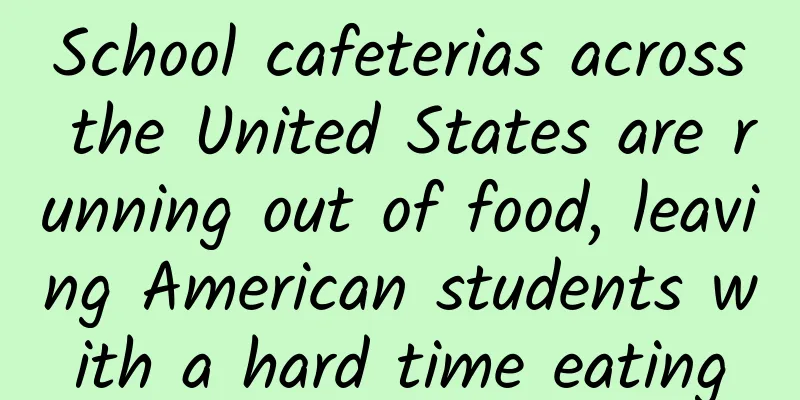School cafeterias across the United States are running out of food, leaving American students with a hard time eating

|
Recently, it was reported that the labor shortage caused by the raging COVID-19 pandemic in the United States has endangered the supply chain, including school cafeterias. Schools across the United States are facing a shortage of cafeteria staples such as chicken and bread, as well as plastic tableware. Affected by labor shortages, food supply and other issues, restaurants in some schools in the United States are facing a food crisis, and children have to bring their own meals to school. "There is no food in the school, please bring your own food next time." "There is no vegetables in the school cafeteria, students can eat some fruit instead." "There is no tableware in the school, eat with your hands." If I don't tell you which country these scenes happened in, would you think they came from some third world country? However, this is what really happened in elementary and middle schools in the United States, the world's number one superpower. The most basic task of feeding students is becoming increasingly complicated by supply chain issues and a lack of truck drivers, with schools across the country facing shortages of cafeteria essentials like chicken, bread, apple juice and even plastic utensils. School canteen supply chain issuesSchool officials say they are rushing to provide meals to students because many rely on the food they eat at school as a significant, and sometimes only, source of daily nutrition. Many educators say they expect supply chain issues to only worsen in the coming months. The problem stems from a series of events, most of them related to the coronavirus pandemic. Labor shortages have plagued food distributors and manufacturers, who say there are not enough people to drive trucks, deliver products from warehouses or work on assembly lines. Jenna Knut, director of food and nutrition services for schools in North Kansas City, Missouri, became increasingly concerned that she would not have enough food to feed the 21,500 students in her district after three major food distributors said they would stop supplying them. As a result, Knut's colleagues regularly went to local Sam's Clubs and catering stores to buy frozen pizzas, potato pancakes and hot dogs in bulk. Many of the products purchased at wholesale stores do not meet federally mandated nutrition standards, Knut said, adding that the foods are not unhealthy, they just have higher sodium and fat content than what the district typically buys. “We are trying to source food wherever we can,” said Knut, who is now “begging” local distributors and suppliers for contracts. Actively coordinate to solve the "food shortage"Beth Wallace, president of the School Meals Association, said the group is asking federal officials to further increase subsidies and temporarily relax requirements that certain products be made in the U.S. A recent survey by the association showed 97% of school meal program leaders were concerned about supply chain disruptions. Cindy Jones, assistant director of food services at the Olathe School District in Kansas, said schools there were without vegetables for two days last month after a delayed delivery. The district had to encourage students to eat more fruit. Jones said delivery trucks typically don't deliver all the food the district has ordered when they arrive, adding that only about 65% of the district's orders are arriving. Food prices have also surged as distributors pass on rising freight prices. Jones said sometimes the district doesn’t know how much it will have to pay until the trucks arrive, forcing it to either accept the cost or risk going short of food. Shortage of various goods in the U.S. due to the coronavirus The report pointed out that it is not just school lunches that have been affected by supply chain disruptions. The COVID-19 pandemic has caused factory closures around the world, leaving many companies with low inventories. This has led to delayed shipments, higher costs and shortages of a variety of goods, including computer chips, bicycle parts and placemats. In Missouri public schools, district officials sent out a notice Sept. 13 encouraging parents to send their children to school with a packed lunch. “If it is not a burden for your family to have your child bring meals from home, we would encourage this option as a short-term requirement,” the notice reads. |
<<: Does Snow White Bougainvillea bloom frequently? When does it bloom?
>>: How to tie a five-pointed star braid for your daughter
Recommend
How to care for lilies in a vase
Lily Vase When we buy lilies, we can put them in ...
How to get high yield from growing loofah in summer?
Luffa is not only a vegetable with high nutrition...
Can lilies be topped?
1. Do you need it? This plant, like many other pl...
Can blue snowflakes be grown indoors?
1. Can be raised indoors Blue snow flower is a pl...
Five things to pay attention to when growing African violets in pots
The size of the African violet potted flowerpot s...
How often should I water the money bag?
How often should I water the money bag? The money...
Can banana trees be planted in the north? Where is it suitable for planting?
Planting banana trees in the north Banana trees c...
How to grow asparagus fern indoors and what to pay attention to
Growth habits of asparagus fern Asparagus fern li...
The main value of Coreopsis grandiflora
The main value of Coreopsis grandiflora: ornament...
What should not be eaten with mango? What fruits should not be eaten with mango?
1. What not to eat when eating mango Garlic: Mang...
What are the varieties of strawberries? Which variety is better?
1. What are the varieties of strawberries? Strawb...
What to do if the peony does not bloom
The important reasons why peonies do not bloom A ...
Wild leek cultivation methods and precautions
Farming methods Fertilization The root system of ...
Breeding methods and precautions of water hyacinth
1. Water quality Water hyacinth is usually grown ...
What should I do if chrysanthemums are infested with insects?
1. Treatment methods Most of the insects on chrys...









